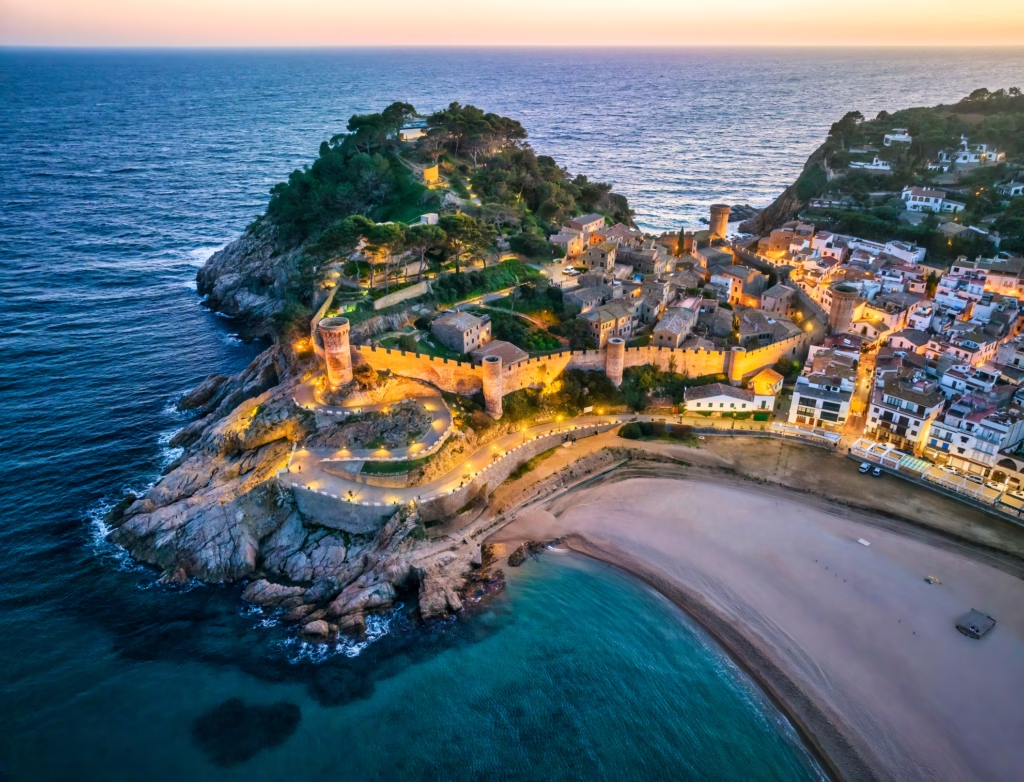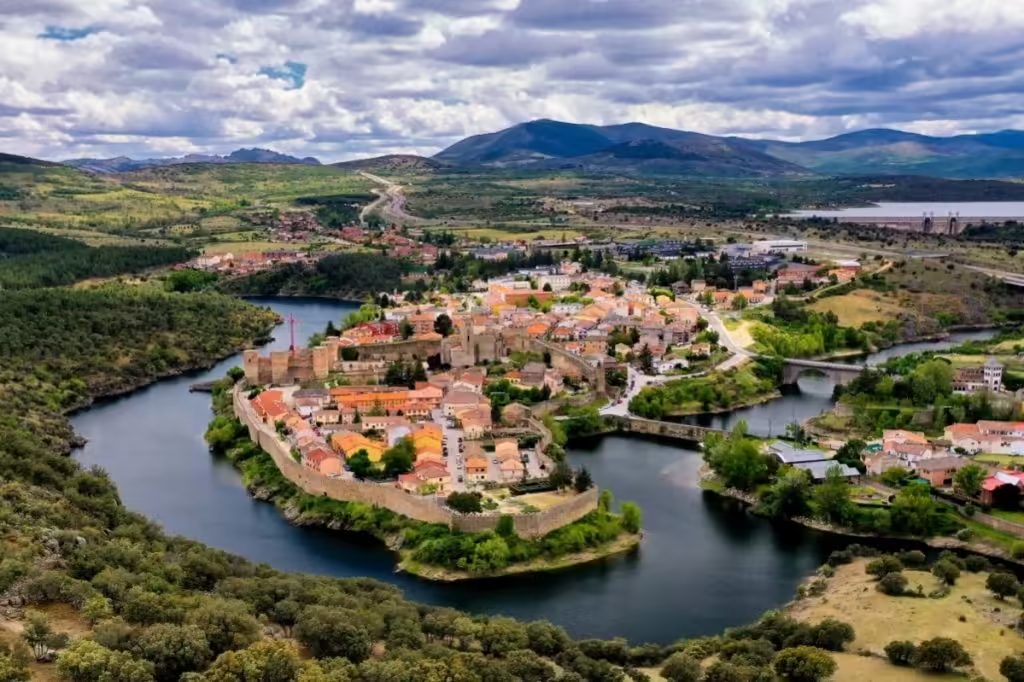Costa Brava is a stunning coastal region in Catalonia, northeastern Spain, that stretches from Blanes, 60 km northeast of Barcelona, to the French border. Known for its rugged coastline, crystal-clear waters, and charming fishing villages, Costa Brava has become a prime destination for travelers seeking a mix of relaxation, adventure, and culture. Whether you’re interested in exploring picturesque beaches, savoring exquisite Mediterranean cuisine, or visiting historical sites, Costa Brava has something for everyone.
In this guide, we’ll cover everything you need to know about Costa Brava, including the best attractions, top things to do, local cuisine, and much more. Get ready to discover the beauty and charm of this Mediterranean paradise.

Why Visit Costa Brava?
Costa Brava has earned its reputation as one of Spain’s most beautiful coastal destinations, offering a perfect blend of stunning beaches, hidden coves, scenic nature trails, and historical sites. Some of the top reasons to visit Costa Brava include:
Breathtaking Coastline: Costa Brava’s coastline is characterized by dramatic cliffs, secluded coves, and pristine beaches. It’s the perfect place for sunbathing, swimming, and enjoying water sports.
Charming Villages: Towns like Tossa de Mar, Cadaqués, and Begur retain their traditional Spanish charm, offering visitors a glimpse into the region’s rich history and culture.
Rich Cultural Heritage: Costa Brava has a diverse cultural heritage, with ancient castles, medieval villages, and the Salvador Dalí Museum in Figueres.
Outdoor Activities: The region is a haven for adventure lovers, offering hiking, kayaking, snorkeling, and cycling opportunities.
Top Attractions in Costa Brava
1. Tossa de Mar: The Gem of Costa Brava
Tossa de Mar is one of the most picturesque towns on the Costa Brava. Its medieval old town, known as Vila Vella, is surrounded by ancient walls and offers stunning views of the coastline. Wander through its narrow cobblestone streets, visit the 12th-century Tossa Castle, and relax on the beautiful Tossa Beach. The town also boasts a great selection of traditional Spanish restaurants, where you can enjoy fresh seafood and regional dishes.
2. Cadaqués: The Artistic Haven
Cadaqués is a small coastal village that has long attracted artists, including the famous surrealist painter Salvador Dalí. Its white-washed houses, narrow streets, and clear blue waters create a picturesque setting that is truly inspiring. Visit the Salvador Dalí House-Museum in Portlligat, where the artist lived and worked for many years. Cadaqués also offers beautiful beaches and a relaxed atmosphere that makes it an ideal getaway.
3. Cap de Creus Natural Park
Located near Cadaqués, Cap de Creus Natural Park is a stunning nature reserve with dramatic landscapes, rocky cliffs, and incredible sea views. It is a great spot for hiking and exploring the region’s natural beauty. The park is also known for its unique rock formations, many of which inspired Dalí’s artwork. Visitors can hike to the Cap de Creus Lighthouse for breathtaking panoramic views of the Mediterranean Sea.
4. Medes Islands Marine Reserve
The Medes Islands are a group of small islands located just off the coast of L’Estartit. They are part of a protected marine reserve, making them an ideal destination for snorkeling and scuba diving. The underwater landscapes are home to a diverse range of marine life, including colorful fish, octopuses, and coral reefs. If you’re interested in exploring the underwater world of Costa Brava, the Medes Islands are a must-visit.
5. Medieval Villages: Pals and Peratallada
Costa Brava is home to several beautifully preserved medieval villages, including Pals and Peratallada. Pals is perched on a hilltop, offering stunning views of the surrounding countryside. The village is characterized by its cobblestone streets, stone houses, and a charming church. Peratallada, on the other hand, is known for its medieval architecture, narrow alleys, and lovely squares. These villages provide a glimpse into Catalonia’s past and are perfect for a day trip.
Best Beaches in Costa Brava
1. Platja de Aiguablava
Platja de Aiguablava is one of the most beautiful beaches in Costa Brava, known for its turquoise waters and golden sand. Surrounded by lush greenery, this beach is ideal for sunbathing, swimming, and snorkeling. There are also a few beachside restaurants where you can enjoy fresh seafood while taking in the stunning views.
2. Cala Sa Tuna
Cala Sa Tuna is a small, picturesque cove near the town of Begur. The beach is surrounded by charming houses and pine-covered hills, giving it a tranquil and secluded feel. Cala Sa Tuna is perfect for those looking to escape the crowds and enjoy a peaceful day by the sea. The crystal-clear waters are ideal for swimming and kayaking.
3. Platja de Tamariu
Platja de Tamariu is a family-friendly beach located in the small village of Tamariu. The beach is known for its calm waters, making it perfect for swimming and paddleboarding. There are also several restaurants and bars along the promenade, offering a great selection of local dishes and refreshing drinks.
Outdoor Activities in Costa Brava
1. Hiking the Cami de Ronda
The Cami de Ronda is a coastal hiking trail that stretches along the Costa Brava, offering stunning views of the sea, cliffs, and hidden coves. The trail is divided into several sections, making it accessible for hikers of all skill levels. Whether you’re looking for a short walk or a full-day hike, the Cami de Ronda provides an incredible way to experience the natural beauty of Costa Brava.
2. Kayaking and Snorkeling
Costa Brava’s clear waters and hidden coves make it an ideal destination for kayaking and snorkeling. You can rent a kayak and explore the rugged coastline, discovering secluded beaches and caves along the way. Snorkeling is also a popular activity, especially around the Medes Islands, where you can see a variety of marine life up close.
3. Cycling Through the Countryside
The inland areas of Costa Brava offer scenic cycling routes that take you through charming villages, vineyards, and olive groves. Cycling is a great way to explore the region at your own pace and enjoy the beautiful landscapes. Many towns in Costa Brava have bike rental shops, and there are guided cycling tours available for those looking for a more structured experience.
Local Cuisine: What to Eat in Costa Brava
Costa Brava is known for its rich culinary traditions, influenced by both the sea and the mountains. Some of the must-try dishes in the region include:
Suquet de Peix: A traditional Catalan fish stew made with a variety of seafood, potatoes, and a flavorful broth.
Paella: While paella is traditionally associated with Valencia, you can find delicious versions of this rice dish along the Costa Brava, often made with fresh seafood.
Esqueixada: A refreshing salad made with salted cod, tomatoes, onions, olives, and olive oil.
Crema Catalana: A traditional Catalan dessert similar to crème brûlée, with a creamy custard base and a caramelized sugar topping.
FAQs About Costa Brava
1. What Is the Best Time to Visit Costa Brava?
The best time to visit Costa Brava is during the spring (April to June) and fall (September to October) months. During these times, the weather is pleasant, and the crowds are smaller compared to the peak summer months. July and August are the busiest months, with warm temperatures and plenty of tourists.
2. How Do I Get to Costa Brava?
Costa Brava is easily accessible from Barcelona, which is the nearest major city. You can drive, take a bus, or join a guided tour to reach the region. Girona-Costa Brava Airport also serves the area, offering direct flights from several European cities.
3. What Are the Best Activities for Families in Costa Brava?
Costa Brava offers plenty of family-friendly activities, including beach days, boat trips, snorkeling, and visiting medieval villages. There are also several water parks in the region, such as Water World in Lloret de Mar, which are great for a fun day out with kids.
4. Is Costa Brava Expensive?
Costa Brava offers a range of accommodation and dining options to suit different budgets. While some towns, like Cadaqués, can be more expensive, there are many affordable options throughout the region. It’s possible to enjoy Costa Brava on a budget by choosing less touristy areas and opting for local eateries.
Conclusion
Costa Brava is a truly enchanting destination that offers something for every type of traveler. With its stunning beaches, charming villages, rich cultural heritage, and diverse outdoor activities, it’s no wonder that Costa Brava is a favorite among both local and international visitors. Whether you’re looking to relax by the sea, explore historical sites, or embark on an outdoor adventure, Costa Brava has it all.
Plan your trip to Costa Brava today and experience the magic of Spain’s northeast coast for yourself!

